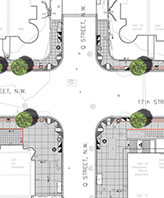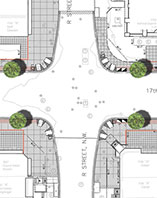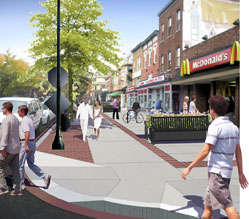Missed opportunities on 17th Street
Last week, DDOT presented mostly-final plans for the 17th Street streetscape redesign in Dupont Circle, from Massachusetts to New Hampshire Avenues. This busy commercial street could use a facelift. And the project will make some valuable improvements and repair run-down elements to make a positive difference for the street. Unfortunately, though, the plan is more notable for the potential improvements it doesn’t contain than those it does.
Click to enlarge. Image by DDOT.
Much of the discussion at the ANC focused around brick versus concrete, which I don’t feel strongly about; ANC members pointed out that brick costs a lot to maintain, can be slippery in winter, and individual bricks tend to pop up and create hazards. While brick is pretty, my street has concrete sidewalks, and looks very inviting because of two things: attractive buildings and trees. 17th’s buildings are more mediocre, but with a better tree canopy and well-maintained sidewalks, it can be a more pleasant place to shop.
Unfortunately, some proposed improvements (like artistic sidewalk designs) were cut in the face of resident opposition. Meanwhile, the project’s scope started modestly from the beginning, excluding some more meaningful improvements like two-way operation or narrower crossings at R Street.
What the plan does:
- Fixes the sidewalks. 17th Street’s sidewalks are a motley patchwork of brick and concrete, some in bad shape. Everything will be redone, primarily as scored concrete. The commercial core, from P to R, will have more intensive scoring to distinguish it from the residential ends. A brick stripe will separate the outdoor seating parts of the sidewalk from the walking parts, and brick will also fill the space between the tree boxes. Essentially, that will create a visual walking “lane”.
- Adds a bike lane. 17th will now have a bike lane along the west side.
- Replaces light fixtures. The intersections will get new teardrop light fixtures, with upright “Washington globes” along the rest of the blocks.
- Rebuilds tree boxes. All tree boxes will have a consistent appearance, and contain cobble paving atop sand. Water will seep through the cobbles and then into the sand where the tree can soak it up.
- Squares up the Q Street intersection (maybe?) Q Street widens slightly as it approaches 17th. This gives cars more space to turn, meaning cars turn at higher speeds and make pedestrians cross a wider space. From the diagram, it appears that Q will get normal square corners. However, once source tells me that the project is only doing the sidewalks, not the curbs, so it might be an error.
What the plan doesn’t do:
- Square up R Street. If Q is a little pedestrian-unfriendly, R is much worse. The intersection was rebuilt fairly recently to create very wide turning radii and push the sidewalks way back at the corners. We should undo that mistake asap, but officials said they couldn’t fix that intersection since it was redone too recently.
Left: 17th and Q with squared corners, as planned(?) in the streetscape design.
Center: 17th and R, unchanged. Right: 14th and U with bulb-outs and decorative
pavement markings, from the 14th Street study.
- Add bulb-outs. Why stop at just squaring up the intersections so the intersection is no wider than the street… we should make them narrower, with bulb-outs at all intersections along such a pedestrian-rich street. The 14th Street plan has many bulb-outs, but this plan has none. If DDOT only had the money to repair the sidewalks, won’t touch any curbs and won’t even fix Q, that makes sense, but is disappointing. But will we be unable to improve the curbs in the relatively near future, once we’ve spent a lot of money on the sidewalks?
- Restore two-way operation on 17th. 17th was originally two-way, as was 15th, but both were converted to one-way during the move-as-many-cars-as-possible era. One way streets are worse for business, since people can only drive past the stores in one direction. But restoring two-way was never presented as an option, despite my hearing some participants suggest it way back at the first meeting about a year ago. Making it two-way would require finding space for loading, since right now many trucks load for the surrounding stores by double parking in one of the two travel lanes. We could accomplish that by replacing some parking with loading zones, though some people always object to losing any parking spaces.
- Add street furniture in the huge voids. 17th between Corcoran and R is perhaps the street’s hub, with Safeway on one side and the hardware store (and McDonald’s) on the other. But it’s one of the street’s least engaging sections, with huge empty expanses of brick and pavement on both sides. The consultants suggested benches and planters, but at last week’s community meeting, most of the 40 people frowned on the idea, saying that homeless people already hang out around the McDonald’s, and benches will just create a place for them to put their belongings and sleep. There are ways to build benches that don’t cater to sleepers, such as armrests dividing the bench into individual seats and downward-curving surfaces which are a little less comfortable but difficult to lie on. Even if benches aren’t the answer, we should put something in this space to break up the visual void and engage people in a greater sense of place at this corner.
- Do anything more attractive. The consultants initially suggested a variety of design elements such as decorative seasonal banners or swirly sidewalk markings. As far as I know, all of these ideas disappeared in the face of criticism from some group of residents or another.
Left: One option presented in December 2007. Right: The recommendation presented last week.
The benches have since been removed from the plan.
- Employ modern stormwater technology. At last night’s Capitol Hill Town Square meeting, landscape architects presented an impressive array of more environmentally friendly tree systems which also help the trees grow better, from permeable pavers which let the rainwater soak into the tree roots, to systems that direct stormwater from the roadbed into the tree boxes. (I’ll post more about that as soon as I get the presentation.) This design has nothing like that.
We’ll get another crack at this street in maybe 10-20 years. Maybe then we can fix R, get bulb-outs and even two-way operation, and cover the sidewalks with something just a little more artistic than pure unadorned concrete squares.
In the meantime, the issue of street furniture in the voids isn’t closed. Perhaps there is a bench design that won’t create the problems residents worry about. Or perhaps we can fill the space with something else, like public art.
The project started out with great potential to beautify the street, even if its scope didn’t include more significant fixes. Unfortunately, it’s morphed into basically a repair project. That’s important. Still, it could have been so much more, and once we spend a lot of money on 17th, it’ll be a while before we can again.





